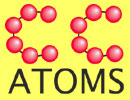
 |
| Home | About | Software | Curriculum | Research |
| Contents of About: About the Project | Proposal |
Home Page ![]() About CC-ATOMS
About CC-ATOMS ![]() Proposal
Proposal ![]() ITR Summary
ITR Summary
| Proposal Contents: |
Today more than ever students
will need flexible mental models of core science concepts in
order to interpret their future jobs. As jobs requiring science
and math increase in numbers, the burgeoning bio-technologies
being only one example, future workers will be asked to learn
new skills rapidly. Understanding why a particular technology
is required is a clear asset. We now have the ability to teach
science concepts more effectively than ever before. The NSF-funded
Molecular Workbench Project (REC 9980620), now in its final year
of research and testing, has developed several powerful atomic-level
models. These models, together called the Molecular Workbench,
when combined with a scripting language that 'talks with"
our model, and with Berkeley's WISE program that delivers on-line
projects in inquiry science, can illuminate some of the hardest-to-teach
concepts.
Community Colleges are a critical gateway not only to career
training but also, for many, to college itself. Offering science
courses ways to insert powerful interactivity with models will
allow students not only to master science, but facilitate their
transfer to specialty courses. The overall goal of this project
is to develop and evaluate the use of complex, interactive computational
models in the real-world situations encountered in two-year college
technical programs. The project will develop and evaluate, flexible
atomic-scale modeling software as well as the software architecture
that supports the rapid development and deployment of educational
materials that utilize this model.
The Molecular Workbench software is capable of underpinning key
physics and some chemistry concepts. Situated between the rigor
of professional science and the simplifications required by good
teaching, its capacity is enhanced by judicious use of algorithms.
This project proposes to develop the modeling software's capacity
to model chemical bonds, photon interactions, new computational
and visualization algorithms needed to model different features
of larger biomolecules (e.g. steric ligand-receptor interactions
at active sites).
Working together with science advisors and a set of community
college educators, this project proposes not only to enhance
the Molecular Workbench software, but also to develop insert
activities using the models, and carefully evaluate their use
and efficacy. We will pilot test this technology in two-year
college courses by providing a range of hypermodels, scaffolded
models that use atomic-scale models to illustrate key science
topics in the context of typical technical specialties. We will
identify a set of key science topics typically taught in biology,
chemistry, and physics courses at this level and generate hypermodels
for each that are based on technologies and processes used in
specialty programs. We will capitalize on an existing platform
for inquiry science projects that has been developed at the University
of California, Berkeley. The Web-based Inquiry Science Environment
(WISE) scaffolds students as they work collaboratively on inquiry
projects. Using WISE, the hypermodels will be integrated into
complete online instructional units that faculty can adapt to
their needs without significant changes in the organization or
learning objectives of current instruction. They will all, however,
have a consistent, atomic-scale approach that could be the basis
of a new, interdisciplinary approach to the core sciences.
The materials will be developed in collaboration with faculty
at two-year colleges and curriculum experts, including Springfield
(MA) Technical Community College (STCC) and others throughout
the US recruited through the Center for Occupational Research
and Development (CORD) and their Community College Presidents
Council. We will identify ten faculty from these colleges who
will assist us in materials development and testing.
Through a project web site, software versions will be released
regularly in both source form and as executables. We will make
all grant-supported code available as open source as part of
our Open Source Library of Educational Technology (OSLET) initiative.
We will also publish on the Internet examples of how to tailor
the objects in its library. The hypermodels and WISE projects
will be available online as soon as complete versions are completed.
Information about these materials will be targeted to educators
through our free newsletter @Concord, CORD publications,
and popular articles. Articles suitable for peer-review about
the software and curriculum materials will be prepared for publication
and professional talks.

This material is based upon work supported by the National Science Foundation under Grant No. EIA-0219345. Any opinions, findings, and conclusions or recommendations expressed in this material are those of the author(s) and do not necessarily reflect the views of the National Science Foundation.
Last Update: 12/10/2018 Maintainer: webmaster@concord.org
Site Map
Copyright © 2018, The Concord Consortium.
All rights reserved.